Albuca bracteata
Albuca bracteata (Thunb.) J.C.Manning & Goldblatt (= Ornithogalum longibracteatum Jacq., O. bracteatum Thunb., O. caudatum Aiton)
Family: Hyacinthaceae
Common names: pregnant onion, false sea onion, sea-onion (Eng.); witui (Afr.); umababaza (isiZulu); masxabana (isiXhosa)
Introduction
A clump-forming bulbous geophyte with green and white flowers on tall stems during summer, the common name pregnant onion is derived from the onion-like appearance of the bulbs and they way they form many small bulblets on the side of the mother bulb.
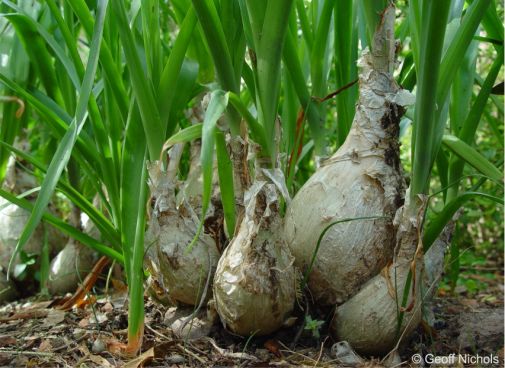
Description
Description
A bulbous plant with arching, lanceolate strap-shaped leaves up to 600 mm long and 25 mm wide, reaching up to 1.5 m tall when in flower. The bulb is very large, up to about 80 mm in diameter, growing above ground, often becoming green, with long, branching, fleshy, white roots. The bulb produces a tall inflorescence with many small flowers in a dense raceme 700-900 mm tall, made up of 50 up to about 300 closely arranged flowers per stalk. The flowers are scented but with an unpleasant smell, white with a broad green central brand (midvein), and a long tapered bract up to 40 mm long with a diameter of about 5 mm. Flowering frequently occurs from early spring through summer to autumn (from August to May in the southern hemisphere). Fruit capsules are 10 mm long and 6 mm in diameter. Seeds are oblong with dimensions of 4 x 1.5 mm.
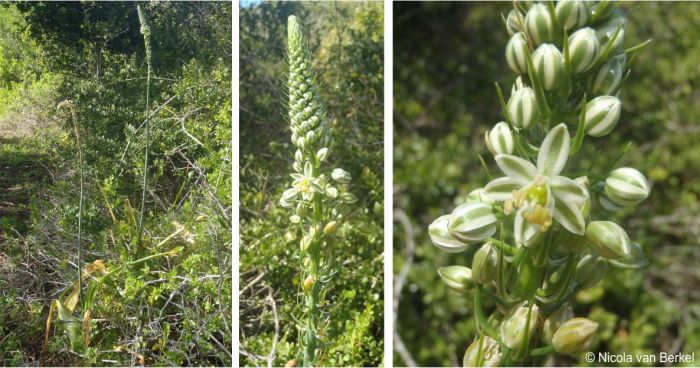
Conservation Status
Status
Least Concern (LC), Albuca bracteata is widespread and common.
Distribution and habitat
Distribution description
Albuca bracteata is a subtropical terrestrial plant that occurs in forest, forest margin, fynbos, Indian Ocean coastal belt, savanna and closed woodland, growing on shaded and sheltered slopes in the Eastern Cape, Western Cape and KwaZulu-Natal, from Mossel Bay on the southwestern coast to the foothills of the Drakensberg and northwards into tropical East Africa.
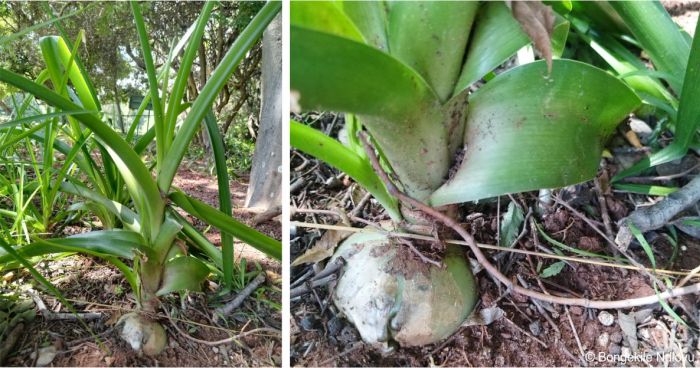
Derivation of name and historical aspects
History
This species is still well known by its old name, Ornithogalum longibracteatum, this name given by Nikolaus Joseph von Jacquin in 1777. Carl Peter Thunberg also described Albuca bracteata, calling it Ornithogalum bracteatum in 1794. The specific epithets longibracteatum, meaning ‘with long bracts’ and bracteatum, meaning ‘with bracts’, refer to the bracts in the inflorescence which are longer than the flowers. Thunberg described the species as bracteis floribus longioribus in Latin, meaning ‘with longer flower bracts’. This species was transferred to Albuca under the newly combined name Albuca bracteata by Manning and Goldblatt in 2009, along with other species of Ornithogalum, based on a molecular phylogenetic study. The species name longibracteata was not used to avoid confusion with a different species, Albuca longebracteata described by Engler in 1892, now synonymous with Albuca virens subsp. virens. The genus name Albuca means ‘white’, from the Latin albus, or ‘becoming white’ from albicans.
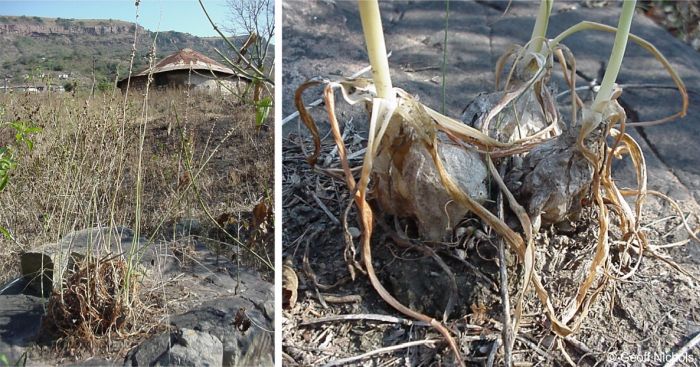
Ecology
Ecology
The bulb is eaten by Chacma Baboons and Nyala have been observed grazing on these plants in KwaZulu-Natal. Tests conducted on this plant found it to be non-toxic, however other species have been shown to be poisonous when eaten.
Albuca bracteata is a cryptophyte, the leaves will die back and the plant becomes dormant during periods of drought. When grown in mild climates with constant moisture, they produce more leaves that are larger and firmer.
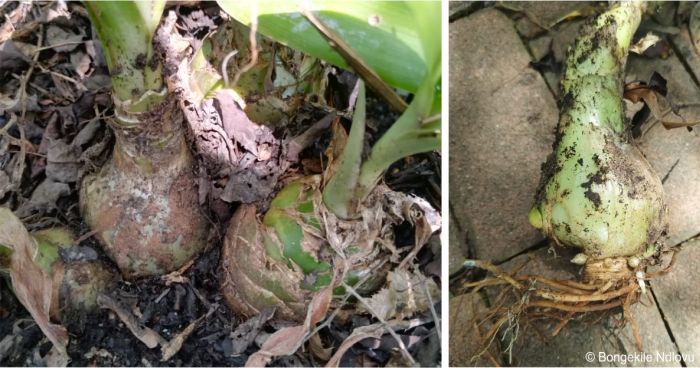
Uses
Use
Umababaza is a powerful sprinkling charm made from the bulbs of this species and used to protect the homestead or village in KwaZulu-Natal. In the Eastern Cape Albuca bracteata is used in traditional remedies to treat diabetes. This plant is considered to be toxic to humans as the sap can cause itching and eczema or contact dermatitis (skin rash).
Albuca bracteata is primarily grown as a houseplant in cold climates and is a rewarding, easy-to-grow potplant. In the garden it is best cultivated in frost-free climates, in well-drained soil in sun, semi-shade or light shade, with water in summer.
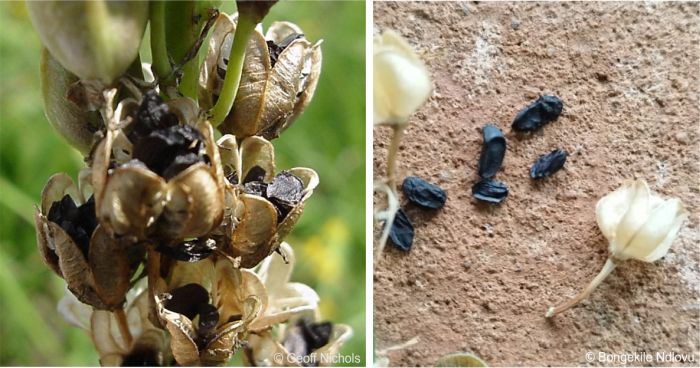
Growing Albuca bracteata
Grow
Albuca bracteata can be grown by both vegetative and sexual reproduction. In sexual propagation, sow seeds in spring or summer and keep them warm and moist, successful germination and survival of the seedlings require consistent watering. In asexual propagation, division is the most practiced method, whereby the bulblets are removed from the mother bulb and planted separately. Seed production provides genetic variation whereas the bulblets are genetically identical to the mother bulb. Micropropagation of Albuca bracteata has been achieved where bulblet production was found to be greatest in vitro between 10–30°C, and was inhibited at 35°C.
References
- Hutchings, A., Scott, A.H., Lewis, G. & Cunningham, A.B. 1996. Zulu medicinal plants: an inventory. University of Natal Press, Pietermaritzburg.
- Jackson, W.P.U. 1990. Origins and meanings of names of South African plant genera. University of Cape Town.
- Manning, J. & Goldblatt, P. 2012. Plants of the Greater Cape Floristic Region 1: the Core Cape Flora. Strelitzia 29. South African National Biodiversity Institute, Pretoria.
- Manning, J.C., Forest, F., Devey, D.S., Fay, M.F. & Goldblatt, P. 2009. A molecular phylogeny and a revised classification of Ornithogaloideae (Hyacinthaceae) based on an analysis of four plastid DNA regions. TAXON 58(1):1-107.
- Obermeyer, A.A. 1978. Ornithogalum: a revision of the southern African species. Bothalia 12,3: 323–376.
- Van Berkel, N. 2013-08. Observation of Albuca bracteata, Wilderness, Western Cape. iNaturalist. Online. https://www.inaturalist.org/observations/10872552.
- Van Huyssteen, M. et al. 2011. Antidiabetic & cytotoxicity screening of five medicinal plants used by traditional African health practitioners in the Nelson Mandela Metropole, South Africa. Afr J Tradit Complement Altern Med 8(2):150–158.
- Von Staden, L. 2012. Albuca bracteata (Thunb.) J.C.Manning & Goldblatt. National Assessment: Red List of South African Plants version. Accessed on 2024/03/06.
- Wikipedia. Albuca bracteata. https://en.wikipedia.org/wiki/Albuca_bracteata. Accessed on 19/02/2024.
- World Flora Online. WFO Plant List. Albuca longebracteata Engl. https://www.worldfloraonline.org/taxon/wfo-0000755191. Accessed 06/03/2024.
Credits
Mlondi Sikhosana, KwaZulu-Natal National Botanical Garden
and Alice Notten, Kirstenbosch National Botanical Garden
March 2024
Acknowledgements: images by Bongekile Ndlovu, Nicola van Berkel and Geoff Nichols.
Plant Attributes:
Plant Type: Bulb
SA Distribution: Eastern Cape, KwaZulu-Natal, Western Cape
Soil type: Sandy, Loam
Flowering season: Spring, Early Summer, Late Summer, Autumn
PH: Acid, Neutral
Flower colour: Green, White
Aspect: Full Sun, Shade, Morning Sun (Semi Shade), Afternoon Sun (Semi Shade)
Gardening skill: Easy
Special Features:
Horticultural zones








Rate this article
Article well written and informative
Rate this plant
Is this an interesting plant?
Login to add your Comment
Back to topNot registered yet? Click here to register.